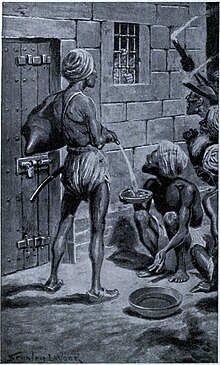
Back الثقب الأسود في كلكتا Arabic কলিকতাৰ কৃষ্ণ কূপ Assamese অন্ধকূপ হত্যা Bengali/Bangla Černá díra v Kalkatě Czech Twll Du Calcutta Welsh Μαύρη τρύπα της Καλκούτας Greek Agujero negro de Calcuta Spanish Trou Noir de Calcutta French Swarte Gat fan Kalkutta Frisian Poll dubh Chalcúta Irish
This article needs additional citations for verification. (June 2017) |

| Part of a series on |
| Bengalis |
|---|
 |
The Black Hole of Calcutta was a dungeon in Fort William, Calcutta, measuring 14 by 18 feet (4.3 m × 5.5 m), in which troops of Siraj-ud-Daulah, the Nawab of Bengal, held British prisoners of war on the night of 20 June 1756.[1][2]: 58 John Zephaniah Holwell, one of the British prisoners and an employee of the East India Company, said that, after the fall of Fort William, the surviving British soldiers, Indian sepoys, and Indian civilians were imprisoned overnight in conditions so cramped that many people died from suffocation and heat exhaustion, and that 123 of 146 prisoners of war imprisoned there died.[3]
Some modern historians believe that 64 prisoners were sent into the Hole, and that 43 died there.[4] Some historians put the figure even lower, to about 18 dead, while questioning the veracity of Holwell's account itself.[5][6]
- ^ Gupta, Brejen K. (1962). Siraj-ud-daullah and the East India Company, 1756–1757. Leiden: E. J. Brill. p. 76.
- ^ Cummins, Joseph (2013). The World's Bloodiest History: Massacre, Genocide, and the Scars They Left on Civilization. New York: Crestline. pp. 56–73. ISBN 9781616734633. Retrieved 12 April 2020.
- ^ Little, J. H. (1916). "The Black Hole – The Question of Holwell's Veracity". Bengal: Past and Present. 12: 136–171.
- ^ Dalrymple, William; Fraser, Olivia (10 September 2019). The anarchy: the relentless rise of the East India Company. New York. ISBN 978-1-63557-395-4. OCLC 1076511649.
{{cite book}}: CS1 maint: location missing publisher (link) - ^ Gupta, Brijen K. (1966). Sirajuddaullah and The East India Company, 1756–1757: Background to the Foundation of British Power in India. Leiden, Netherlands: E. J. Brill. pp. 70–80.
- ^ Dirks, Nicholas B. (2008). The Scandal of Empire – India and the Creation of Imperial Britain. Cambridge, Massachusetts: The Belknap Press of Harvard University Press. pp. 3–4. ISBN 978-0-674-02724-4.